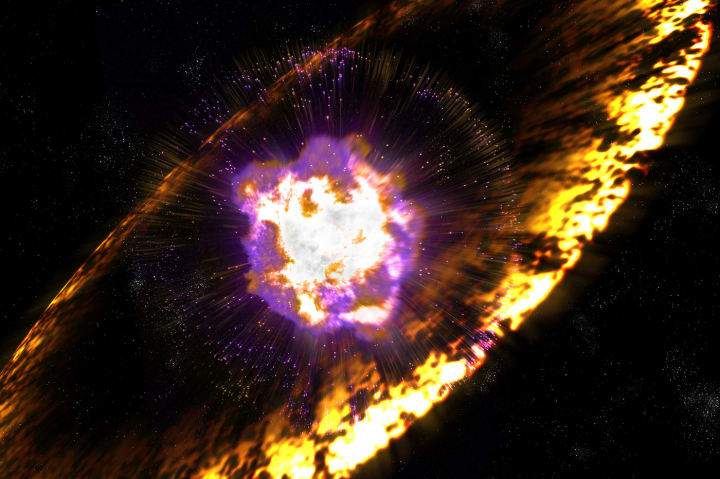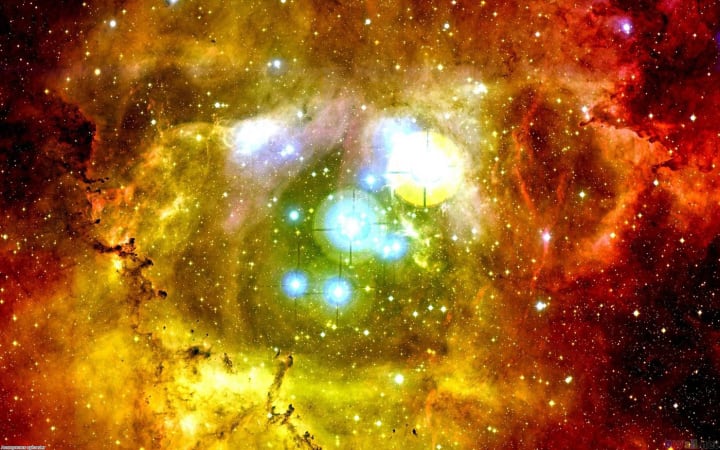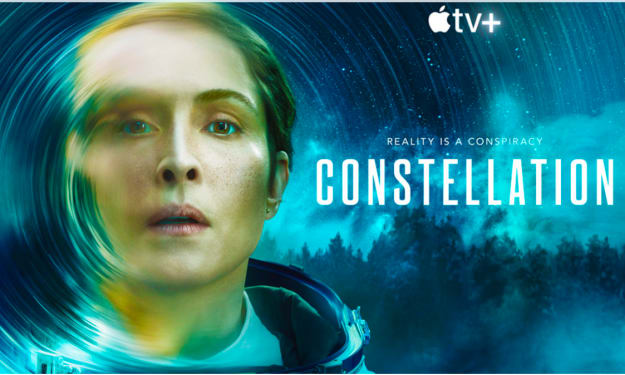Infinite Mystery of Light
Light is an infinite mystery, from photons to supernovae, and the various unexplored implications yet to be discovered!

The following article was originally published on The Free Advice Man's website here.
Our Magnificent Star, The Sun, emits Photons that reach our fragile little planet Earth after traveling in the relative vacuum of outer-space for a time duration of roughly Eight Minutes, and at a Speed that is considered to be the Relative Speed Limit of The Universe, The Speed of Light, which is approximately 11,176,943.8 miles per minute! Which is 670,616,629 miles per hour, or 5.87849981 × 1012 miles per year! The nearest Star to our Star is actually a Binary Star System (two Stars orbiting one-another) that is located 4.37 Light-years distance from our Sun! A Light-year distance is 5.87849981 × 1012 miles! Anyway; guess what! All the plant food and animal proteins you and I and all fauna and flora consume on this planet are packages of energy, or more precisely photons emitted by the Sun transferred electromagnetic radiation energy from the Sun to plants and animals on Earth, (with a fraction of energy from other sources) and so we are essentially energized by our Star The Sun's photons! The Light that allows us to see one-another is also the Light that allows us to be one-another! We are Enlightened by Light!
Photons are wavicles that are emitted from Electrons orbiting the Nucleus of an Atom when there is an increase in the speed at which they orbit the nuclei. The faster an Atom's Electrons revolve around the Atom's Protons and Neutron-filled Nucleus, the closer the Electrons get to the Nucleus and the more excited they become, and eventually they release stored photons, or Photon Wavicles. These Photon Wavicles are Worm-like Particles that, once released by over-excited Electrons, shoot out at a constant speed, even as they wriggle in a a hyper-super-fast manner in the direction they have been ejected! An Atom whose electrons move faster is itself an atom that has been energized by some force influencing it: a chemical fire, friction, nuclear fission, etc. The more energized an Electron, the closer it will orbit its Atom's nucleus; the more Photons it will eject.
A photon is an elementary particle, a quantum "thingy" (wavicle?) of light, as well as all other forms of electromagnetic radiation (gamma rays, x-rays, Infra-Red, Ultraviolet, Microwaves, UHF, VHF, etc.). It is the force carrier for the electromagnetic force, even when static via virtual photons. The effects of this force are easily observable at the electronoscopic (sub-nano-microscopic) and at the macroscopic (telescopic and radio-telescopic) level. A photon has zero rest gravitational mass and is not subject to the same laws of inertial mass gravity as other particles. Photons are absorbed and ejected but never disintegrate, albeit theoretically after billions of billions of years they might! As with all elementary sub-atomic particles, photons are currently best understood by their specific quantum mechanics and exhibit wave-particle duality, sharing properties of both waves and of particles. For example, a single photon may be refracted by a lens or exhibit wave interference with itself, but also act as a particle giving a definite result when its position is measured. What that implies is rather mysterious! Because it would seem that a Photon, when traveling at its optimal speed in a relative vacuum of space, becomes elongated and yet moves in a wave-like formation! A wavicle! Which leads Theoretical Physicists to consider the possible likelihood that Photons themselves have even smaller sub-Photonic particles that can travel even faster than light! But if that is true, then those particles would not be able to transmit any information at all, and we would not be able to in any way observe them! Photons are described by quantum electrodynamics (QED), one of the most successful theories we have, to the point where any deviation from its predictions must happen at the edge of measure-ability. The speed of light is exclusively special: Nothing with mass can move at that speed, or accelerate to it, because it would explode into sub-atomic particles as soon as it got too close to approaching the speed of Light! Einstein first arrived at that realization by studying the equations governing light known as Maxwell’s equations of electromagnetism. We could call the speed of light (c for "constant") the speed of gravity instead, since general relativity predicts that gravity waves propagate at the "speed of light."
If you are reading this sentence by means of the visual sensing mechanism of your eyes and optical or visual cortex of your brain, then most of what comprises the blackness of the type-font used here is seen on account of the surrounding bright white light and hardly any light is being reflected off the blackness of the font-type itself. But you're not seeing actual photons. Only the cumulative effect of such photons on your optical nerves and the patterns of electro-chemical impulses that generate images in the back of your brain! But here's the thing: Somehow you are able to consciously modify the images of your dreams and visualizations! Never mind all the so-called evidence that seems to suggest that free will is an illusion and we're actually being directed by biochemical factors beyond our control. Sure, most of the time that is the actual case! But the very fact that you can imagine things and choose to ignore continuing to imagine other things is evidence that, at some level of existence, you do have some conscious control over your thoughts and even your actions! Very highly imaginative people, known to most average-minded people (who are also labelled "mediocre-minded") as geniuses, can be so unpredictable in their thoughts and reactions that they would falsely appear as mad or insane to most other people! And, indeed, creative hyper-imaginative geniuses are far more vulnerable to becoming truly insane or mad, as compared to most other people. That said, the types of insanity or madness exhibited by those who were once geniuses is most often relatively harmless to others. Insanity in mediocre-minded people is the kind one should be most concerned about, because such average-minded persons are capable of causing great harm to others. Then again, one has to wonder what the World would really be like if most people were real geniuses, and would thus be hyper-imaginative and creative. To my way of thinking, such a World would be far safer and more delightful. Real geniuses tend to have great Wisdom, because they tend to be more sensitive and empathetic and ethical towards others, and appreciate life's natural pleasures and intellectual joys far more so than those who simply endanger themselves and others by inducing uncontrollable mental experiences! Substance abuse and real genius almost never go hand in hand. And any genius who somehow falls into the trap of substance abuse, or is shoved into substance abuse, will quickly lose their ability to think the way geniuses do.
But let's not go too far off the main topic: Light and Photons.

via Space
Our current photon model concept was the result of gestalt-experimentums (thought experiments, i.e. imaginations) conducted by Albert Einstein to explain experimental observations that did not fit the classical wave model of light. Specifically, Einstein's photon model accounted for the frequency dependence of light's energy, and explained the ability of matter and radiation to be in thermodynamical equilibrium. It also accounted for anomalous observations, including the properties of black-body radiation, that other physicists, most notably Max Planck, had sought to explain using semi-classical models, in which light is still described by Maxwell's equations, but the material objects that emit and absorb light do so in amounts of energy that are quantized (i.e., they change energy only by certain particular discrete amounts and cannot change energy in any arbitrary way). Although these semi-classical models contributed to the development of quantum mechanics, many further experiments starting with Compton scattering of single photons by electrons, first observed in 1923, validated Einstein's hypothesis that light itself is quantized. In 1926, the optical physicist Frithiof Wolfers and the chemist Gilbert N. Lewis coined the name photon for these particles, and after 1927, when Arthur H. Compton won the Nobel Prize for his scattering studies, most scientists accepted the validity that quanta of light have an independent existence, and the term photon for light quanta was accepted.
Albert Einstein's "Zur Elektrodynamik bewegter Körper" ("On the Electrodynamics of Moving Bodies"), his third major breakthrough paper in the year 1905, which Scientists often refer to as the Annus Mirabilis (Miraculous Year), reconciled Maxwell's equations for electricity and magnetism with the laws of mechanics by introducing major changes to how quantum mechanics functioned at speeds approximating the speed of light. This particular paper later became known as Einstein's Special Theory of Relativity (STR). In it, Einstein mentions the names of only five other scientists, Isaac Newton, James Clerk Maxwell, Heinrich Hertz, Christian Doppler, and Hendrik Lorentz. It made no references to any other publications, and many of the ideas it contained had already been published by others, as detailed in history of special relativity and the relativity priority dispute. However, Einstein's paper introduces a novel theory of time, distance, mass, and energy that was consistent with all the known specific mechanics of electromagnetism, but omitted the force of gravity. It was only in his Fourth Paper, published later that same year, 1905, that Einstein developed an argument for arguably the most famous equation in the field of physics: E = mc2.
2015 was The Official International Year of Light, as declared by UNESCO, The United Nations Educational, Scientific and Cultural Organization.
The image of someone you see in front of you is relative to the distance between you and that person, and the fact that your eyes are unable to focus in on all the nano-explosions of energy that are happening at the atomic and sub-atomic level of reality! You are only seeing some limited amount of reality. If you could see all the bursts of energy you would go blind almost instantly.
And to think that when you are looking at a distant star or galaxy, the photons reaching your eye have been traveling for thousands, or millions, or even billions of years. You are seeing things not as they are "now," but as they were way back then! If suddenly most of the rest of the Universe seized to exist in an atomic-chemical-level state you would not know about it until much later, if ever at all!
The Photon teaches us that we really do not know what the Universe is Ultimately about! Our observations are imperfect. Many of my fellow Theorists are willing to accept, unquestionably, that what we observe as Red Shift is proof that the Universe is expanding and all stars and galaxies are getting more and more distant from one another, and that therefore we must conclude that everything we can observe began as part of a Big Bang. But The Big Bang Theory is just that: a Theory! And it is not the only plausible theory as far as the nature of The Universe is concerned. There is a significant alternative theory. I am a long-time early Signatory to this alternative theory.
An Open Letter to the Scientific Community
(Published in New Scientist, May 22, 2004)
The big bang today relies on a growing number of hypothetical entities, things that we have never observed—inflation, dark matter, and dark energy are the most prominent examples. Without them, there would be a fatal contradiction between the observations made by astronomers and the predictions of the big bang theory. In no other field of physics would this continual recourse to new hypothetical objects be accepted as a way of bridging the gap between theory and observation. It would, at the least, raise serious questions about the validity of the underlying theory.
But the big bang theory can't survive without these fudge factors. Without the hypothetical inflation field, the big bang does not predict the smooth, isotropic cosmic background radiation that is observed, because there would be no way for parts of the universe that are now more than a few degrees away in the sky to come to the same temperature and thus emit the same amount of microwave radiation.
Without some kind of dark matter, unlike any that we have observed on Earth despite 20 years of experiments, the big bang theory makes contradictory predictions for the density of matter in the universe. Inflation requires a density 20 times larger than that implied by big bang nucleosynthesis, the theory's explanation of the origin of the light elements. And without dark energy, the theory predicts that the universe is only about 8 billion years old, which is billions of years younger than the age of many stars in our galaxy.

What is more, the big bang theory can boast of no quantitative predictions that have subsequently been validated by observation. The successes claimed by the theory's supporters consist of its ability to retrospectively fit observations with a steadily increasing array of adjustable parameters, just as the old Earth-centered cosmology of Ptolemy needed layer upon layer of epicycles.
Yet the big bang is not the only framework available for understanding the history of the universe. Plasma Cosmology and The Steady-State model both hypothesize an evolving universe without beginning or end. These and other alternative approaches can also explain the basic phenomena of the cosmos, including the abundances of light elements, the generation of large-scale structure, the cosmic background radiation, and how the redshift of far-away galaxies increases with distance. They have even predicted new phenomena that were subsequently observed, something the big bang has failed to do.
Supporters of the big bang theory may retort that these theories do not explain every cosmological observation. But that is scarcely surprising, as their development has been severely hampered by a complete lack of funding. Indeed, such questions and alternatives cannot even now be freely discussed and examined. An open exchange of ideas is lacking in most mainstream conferences. Whereas Richard Feynman could say that "science is the culture of doubt," in cosmology today doubt and dissent are not tolerated, and young scientists learn to remain silent if they have something negative to say about the standard big bang model. Those who doubt the big bang fear that saying so will cost them their funding.
Even observations are now interpreted through this biased filter, judged as right or wrong depending on whether or not they support the big bang. So discordant data on red shifts, lithium and helium abundances, and galaxy distribution, among other topics, are ignored or ridiculed. This reflects a growing dogmatic mindset that is alien to the spirit of free scientific inquiry.
Today, virtually all financial and experimental resources in cosmology are devoted to big bang studies. Funding comes from only a few sources, and all the peer-review committees that control them are dominated by supporters of the big bang. As a result, the dominance of the big bang within the field has become self-sustaining, irrespective of the scientific validity of the theory.
Giving support only to projects within the big bang framework undermines a fundamental element of the scientific method—the constant testing of theory against observation. Such a restriction makes unbiased discussion and research impossible. To redress this, we urge those agencies that fund work in cosmology to set aside a significant fraction of their funding for investigations into alternative theories and observational contradictions of the big bang. To avoid bias, the peer review committee that allocates such funds could be composed of astronomers and physicists from outside the field of cosmology.
Allocating funding to investigations into the big bang's validity, and its alternatives, would allow the scientific process to determine our most accurate model of the history of the universe.
THIS was signed by several hundred prominent persons, including Accredited Academics in all fields relevant to Theoretical Physics. Myself included.
And yes, some further "evidence" has been found for both The Big Bang Theory and our Alternative Ones! What is certain is that Tired Light is real. And so is the logic of Infinity!
About the Creator
Jean-Pierre Fenyo
American philosopher, writer, and audio-visual artist. Author of The Most Important Thought and founder of the NGO The Infinity Society.






Comments
There are no comments for this story
Be the first to respond and start the conversation.